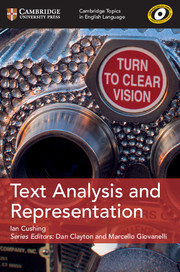Text Analysis and Representation Digital edition is a general introduction to the methods and principles behind English linguistics study, suitable for students at advanced level and beyond. Written with input from the Cambridge English Corpus, it looks at the way meaning is made using authentic written and spoken examples. This helps students give confident analysis and articulate responses. Using short activities to help explain analysis methods, this digital resource guides students through major modern issues and concepts. It summarises key concerns and modern findings, while providing inspiration for language investigations and non-examined assessments (NEAs) with research suggestions.
Features
- Personalise Digital editions to your needs – set homework, link to the web and share annotations with your class.
- Instruction in analysis techniques and research methodology, as well as examples of academic writing at an accessible level, give students models to follow for their own work.
- Examples from the Cambridge English Corpus give students access to prestigious academic global English research, as well as insight into corpus linguistics and techniques for corpus creation and analysis.
- Wider reading suggestions guide students towards broader topic exposure, encouraging them to research areas that interest them.
- Longer research tasks encourage a greater depth of application and provide inspiration for non-examined assessment (NEA).
- Written to support A Level and IB qualifications: in particular Cambridge International A Level English Language (9093) Paper 3 Text Analysis and Paper 4 Language Topics, AS & A Level English Language, AS & A Level English Language and Literature and IB English A.
- Short activities and exam-style questions provide practice and help students get a deeper understanding of key concepts.
- The Digital edition is simple to navigate for both students and teachers – find notes quickly with highlights and bookmarks.
- Simple and easy to use, link directly into Cambridge Digital from Moodle, Blackboard and any other VLE.
- Access a library of Cambridge books anywhere, anytime whether online or offline (via the app). For more information, please visit cambridge.org/go.
- Accessibility Information: The accessibility information of this publication is unknown.
Table of Contents
- 1. What is text analysis and representation?:
- 1.1. Big issues
- 1.2. Discourse
- 1.3. Context
- 1.4. Meaning
- 1.5. Register
- 1.6. What is a text?
- 1.7. Using metalanguage
- 1.8. Participants in discourse
- 1.9. Language as a system of meaning
- 1.10. Mode and genre
- 1.11. Purpose
- 1.12. Approaches to analysing texts
- 2. The structure of language: building words:
- 2.1. How language is organised
- 2.2. Phonetics and phonology
- 2.3. Grammar: building words
- 2.4. Categories of words
- 3. The structure of language: building sentences:
- 3.1. Distribution
- 3.2. Phrases
- 3.3. Clauses
- 3.4. Functions
- 3.5. Active and passive voice
- 3.6. Sentences
- 4. Creating meaning:
- 4.1. Negotiating meaning: semantics and pragmatics
- 4.2. Knowledge
- 4.3. Networks of words
- 4.4. Metaphor
- 4.5. Modality
- 4.6. Building and representing the world
- 5. Spoken language:
- 5.1. Working with spoken language
- 5.2. Speech acts
- 5.3. Narrative
- 5.4. Multi-speaker interaction
- 5.5. The social nature of speech
- Ideas and answers
- References.
Advice on useful tools
Advice on useful tools, activities and timetabling from teachers experiencing school closures.
Cambridge GO
All our supporting resources have now moved to Cambridge GO – the new home for your Cambridge digital content.
Listen to our podcast
Listen to our podcast to discover teaching inspiration & advice from leading educational thinkers.




